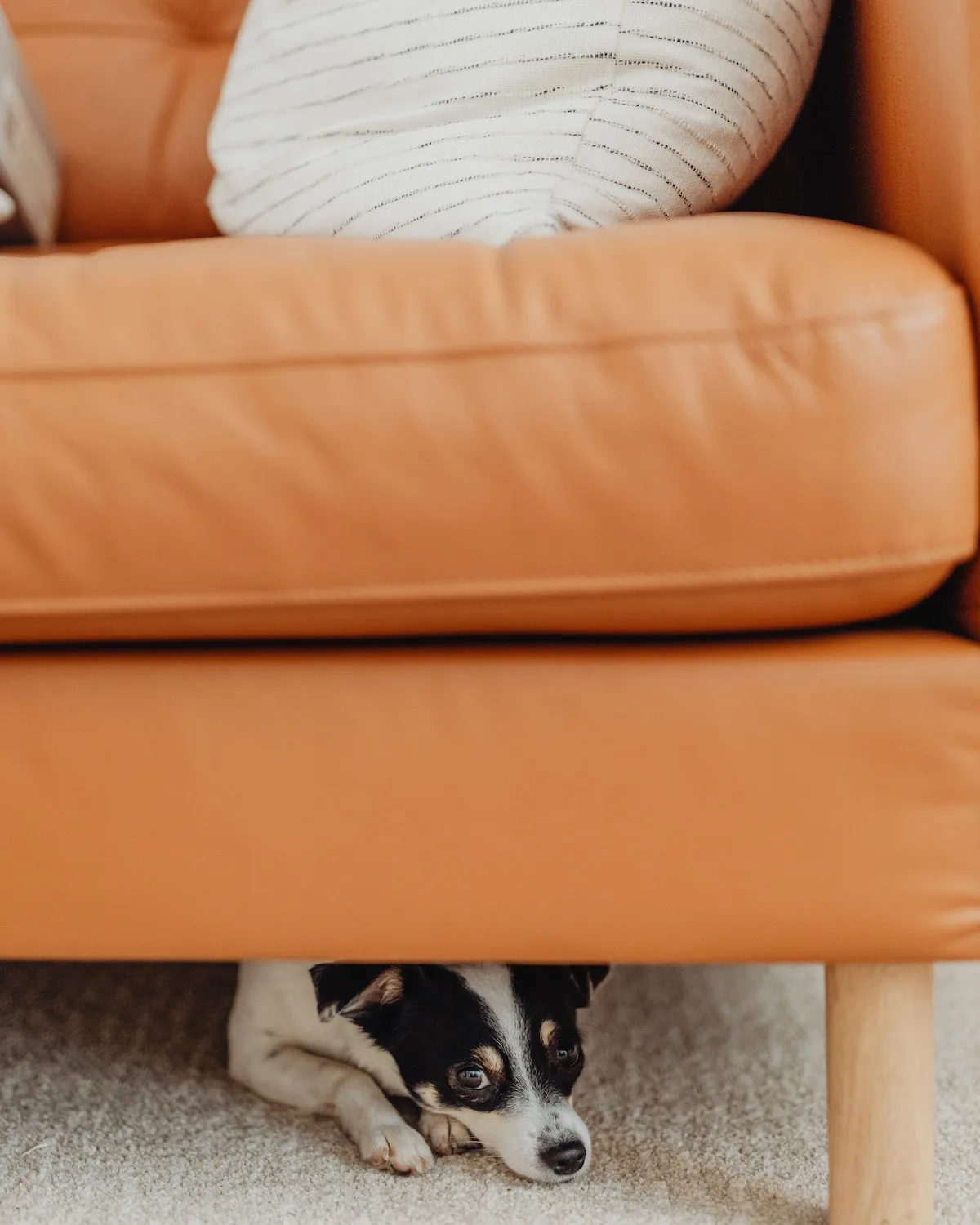Dogs, like humans, experience fear and anxiety. What makes a scared looking dog? In this article, we’ll cover some cues and body language of a fearful or scared dog. By understanding their signals, we can address the underlying issue to help them feel safe and secure.

Recognizing anxiety and fear in dogs
It’s important to learn to identify signs of fear in dogs. Unlike the play bow, these signs can show as cowering, trembling, a tucked tail, lowered ears, avoiding eye contact, wide eyes, panting, spinning and even covering their nose. If you’ve ever seen an anxious Belgian Malinois spinning you would get dizzy.
These expressions indicate their discomfort, anxiety and apprehension, not to be mistaken for a dumb or aloof personality. They allow us to identify the source of fear and respond appropriately. Dogs, just like humans, can experience an unhealthy rapid increase in cortisol, the stress hormone, during these times.
If you really want to get into the weeds about how unhealthy fear can be to an animal Temple Grandin’s Distress in Animals: Is it Fear, Pain or Physical Stress? is a great read.
One common example that often results in a scared looking dog is loud noises, fireworks or thunderstorms. Oftentimes the dog will exhibit all of the above signs and even try to run away from the noise, which to a human would seem illogical.
However, if one looks at it through the lens of the dog they would understand that according to an article published by Smithsonian Magazine, dogs can hear more than twice as many frequencies as humans and they can also hear sounds roughly four times further away.
Furthermore, most dogs have a genetic disposition or survival instinct to run away from a perceived threat. I personally observed this in a previous working dog that would run from his indoor kennel to the outside kennel and cower in a thunderstorm instead of just staying inside where it was safe and dry.
Which leads us to the next section.

Understanding and identifying triggers
A fear trigger is something that is seen or heard and arouses an emotion of fear which could be a result of a traumatic experience. It is extremely important to identify common triggers that can make a dog appear scared, such as loud noises, unfamiliar environments, or past traumatic experiences.
By identifying these triggers, we can minimize their exposure or gradually desensitize them to build confidence. Sometimes it can be extremely difficult to identify these triggers. For example, an article written by the AKC showed that most dogs can detect changes in the weather. This behavior can precede the actual noise from the thunderstorm which could be miles away.
When looking for triggers we should be looking for the change in behavior or expressions of the dog and identifying what is occurring around the dog at that time.
Some common triggers include thunderstorms, fireworks, alarms, commercial vehicles such as garbage trucks, gunshots, slippery floors, elevators, vacuums, stairs, being placed onto higher surfaces, being left alone, water hoses, etc.

Creating a safe environment for a scared looking dog
Once you have identified the cause of your dog’s fear you can immediately begin to provide a secure space where the scared dog can avoid continued exposure to these stressors.
A quiet area with familiar bedding (maybe even the foot of your bed) and toys can help alleviate anxiety and provide a sense of comfort and stability. Similar to how you would reduce stranger anxiety in babies, once you are able to control the environment you can begin to work on desensitizing the dog to this fear.
Distance is your friend when doing so. For example, if my dog was scared of moving cars I would not start this process three feet away from a moving car. I would start at a distance that the dog was not reacting to the stressor and slowly work our way closer over time.
Just like when training a dog on e collar, the utilization of positive reinforcement techniques, such as treats and praise, to build trust and confidence is paramount to this process. Using a conditioned reinforcer such as a clicker is an easy way to communicate to the dog that what they are experiencing and doing is good and a treat is coming soon. Through repetition, patience and time you can train your dog to not be scared of certain stressors.
Is all fear resolvable?
My experience has led me to believe unfortunately no. Not all fears can be resolved with 100% certainty in dogs. It’s important to note that if a dog’s fear persists or intensifies, consult a professional dog trainer or a veterinary behaviorist.
A scared dog can exhibit aggression out of fear. Just because some fears are unresolvable does not mean that we can not alleviate those fears by controlling their environment and limiting the exposure of those stressors to the dog.

